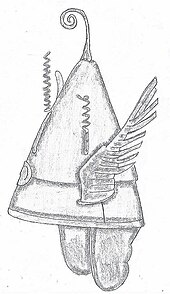Pilos helmet
The Piloshelm (also Pilos helmet or Konoshelm ) is a helmet from the time of ancient Greece . It has a conical shape and does not have a protruding brim, but often has a stepped edge. The original material was felt , later the helmets were made in bronze in the same shape . The helmets could have cheek flaps and various decorations.
The Spartan hoplites used the heavy Corinthian helmet for a long time , which also protected most of the face, but also restricted vision and hearing. Middle of the 5th century BC The Spartan combat tactics changed; the soldiers had to carry out complex maneuvers announced by trumpet signals. This combat tactic required lighter, non-restrictive equipment. The name of the helmet comes from the felt cap Pileus / Pilos , which has the same shape and was probably also worn under this helmet. It is very likely that piloi, made of both thick felt and bronze, were used as weapons of protection; partly by the hoplites themselves, partly by their auxiliaries, while the hoplites wore pilos helmets in bronze at the same time.
The helmet was copied by different cultures inside and outside the Peloponnesian League , including Carthage and Macedonia .
See also
literature
- Petros Dintsis: Hellenistic Helmets. (= Archaeologica. 43). G. Bretschneider, Rome 1986, ISBN 88-85007-71-6 , pp. 58-60 (also: Wien, Univ., Diss., 1982).
- Hermann Pflug : Antique helmets (= art and antiquity on the Rhine. No. 129). Rheinland-Verlag, Cologne 1989, ISBN 3-7927-1112-5 , pp. 22, 38.
Web links
- thefakebusters.com: Overview of ancient Greek helmets , examples of pilos helmets
Individual evidence
- ↑ Nicholas Second: Macedonian Armies after Alexander 323-168 BC. Osprey Publishing, ISBN 1-78200-322-3 , p. 64. (Excerpt from Google Books)
- ↑ Nic Fields: Carthaginian Warrior 264-146 BC. Osprey Publishing, 2010, ISBN 978-1-84603-958-4 , p. 40. (Excerpt from Google Books) ; Pamela A. Webb: Hellenistic Architectural Sculpture: Figural Motifs in Western Anatolia and the Aegean Islands. University of Wisconsin Press, 1996, ISBN 0-299-14980-3 , p. 58. (Excerpt from Google Books)
- ↑ Nicholas Second: Macedonian Armies after Alexander 323-168 BC. Osprey Publishing, ISBN 1-78200-322-3 , p. 64. (Excerpt from Google Books)
- ^ Hermann Historica: Italian Pilos helmet from the Axel Guttmann collection .
- ↑ Nicholas Seconda: The Ancient Greeks , Osprey Publishing, 1986, ISBN 0-85045-686-X , p. 23. (excerpt from Google Books) ; Nicholas Seconda: The Spartan Army. Osprey Publishing, 1998, ISBN 1-85532-659-0 , p. 30. (excerpt from Google Books)
- ↑ John Kinloch Anderson: Military Theory and Practice in the Age of Xenophon. University of California Press, 1970, ISBN 0-520-01564-9 , pp. 29-37. (Excerpt from Google Books)
- ↑ Nicholas Seconda: The Spartan Army. Osprey Publishing, 1998, ISBN 1-85532-659-0 , p. 30. (excerpt from Google Books)
- ↑ Nic Fields: Carthaginian Warrior 264-146 BC. Osprey Publishing, 2010, ISBN 978-1-84603-958-4 , p. 40. (Excerpt from Google Books)
- ↑ Waldemar Heckel: Macedonian Warrior: Alexander's Elite Infantryman. Osprey Publishing, 2006, ISBN 1-84176-950-9 , p. 16. (excerpt from Google Books)

